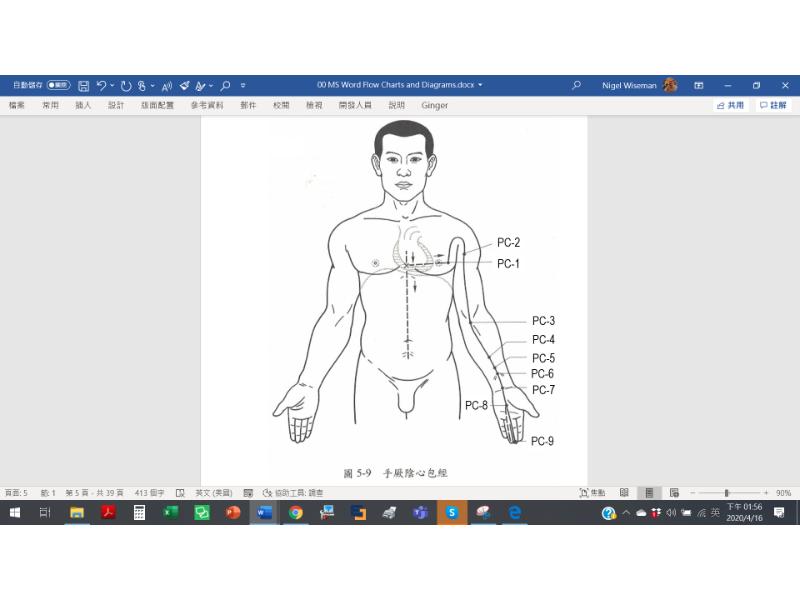Search in dictionary
Hand reverting yīn (jué yīn) pericardium channel
手厥阴心包经 〔手厥陰心包經〕 shǒu jué yīn xīn bāo jīng 🔗
Abbreviation: PC. One of the twelve channels.
 |
| Hand reverting yīn (jué yīn) pericardium channel |
|---|
Connections
KI → PC → TB; homes to the pericardiac network; nets the triple burner.
Pericardium Channel Pathway
Overview
- Chest → homes to pericardium → nets upper, center, and lower burners.
- Branch 2: chest →
axilla (armpit) → midline of the extensor aspect of the upper limb → tip of the middle finger . - Branch 2: Palm → ulnar aspect of the fourth finger → tip → TB channel (TB-1).
Description
The hand reverting yīn (jué yīn) pericardium channel starts from within the chest, where it homes to the pericardium. It then descends through the diaphragm into the abdomen, successively netting the upper, middle, and lower burners.
A branch (1) separating in the center of the chest runs out horizontally to emerge at the rib-side 3 cùn below the anterior axillary fold at PC-1 (天池 tiān chí, Celestial Pool), and then skirts around the axilla to the medial aspect of the upper arm. From here, it runs down the midline of the medial aspect of the upper arm between the hand greater yīn (tài yīn) lung channel and the hand lesser yīn (shào yīn) heart channel, crosses the center of the cubital fossa (the pit of the elbow), then proceeds down the forearm between the two sinews
(the tendons of the palmaris longus and flexor carpi radialis muscles). It travels through the palm and along the ulnar aspect of the middle finger until it reaches the tip (PC-9, zhōng chōng, Central Hub).
Another branch (2) separates in the palm and proceeds along the ulnar aspect of the fourth finger to its tip, where it meets the hand lesser yáng (shào yáng) triple burner channel at TB-1 (guān chōng, Passage Hub).
Pericardium Channel Acupoints
Indications of PC Acupoints
The 9 points on the hand reverting yīn (jué yīn) pericardium channel treat diseases of the heart, spirit-mind, chest, stomach and other conditions in areas traversed by the channel.
- Heart, spirit-mind, and chest: Heart pain, heart palpitation, heart vexation, mania and withdrawal, oppression in the chest.
- External pathway: Swelling of armpits, hypertonicity of the elbow and upper arm, heat in the palms.
Major PC Acupoints
PC-4 (郄门 xī mén, Cleft Gate): Located on the palmar aspect of the forearm, 5 cùn proximal to the wrist crease, between the tendons of the palmaris longus and the flexor carpi radialis muscles.
- Indications: Heart pain; heart palpitation; vomiting of blood (blood ejection); coughing of blood; clove sores (dīng chuāng); epilepsy.
- Stimulus: Needling: 0.5–0.8 cùn perpendicular insertion. Moxa: 5–7 cones; pole 5–20 min.
- Categories: Cleft point (xī xué) of the pericardium channel.
| Indications for PC Points |
|---|
|
PC-5 (间使 jiān shǐ, Intermediary Courier): Located on the palmar aspect of the forearm, 3 cùn proximal to the wrist crease, between the tendons of the palmaris longus and the flexor carpi radialis muscles.
- Indications: Heart pain; heart palpitation; stomach pain; retching and vomiting; febrile disease; malarial disease; mania and withdrawal; epilepsy.
- Stimulus: Needling: 0.5–1. 0 cùn perpendicular insertion. Moxa: 3–5 cones; pole 5–15 min.
- Categories: River (jīng) (metal) point.
PC-6 (内关 nèi guān, Inner Pass): Located on the palmar aspect of the forearm, 2 cùn proximal to the wrist crease, between the tendons of the palmaris longus and the flexor carpi radialis muscles.
- Indications: Heart pain; heart palpitation; oppression in the chest; stomach pain; retching and vomiting; epilepsy; febrile disease; malarial disease; impediment pain of the upper limbs; hemiplegia; insomnia; dizziness; hemilateral headache.
- Stimulus: Needling: 0.5–2.0 cùn perpendicular insertion. Moxa: 3–5 cones; pole 5–15 min.
- Categories: Network point (luò xué); confluence point (bā mài jiāo huì xué) of the yīn linking vessel (yīn wéi mài).
PC-7 (大陵 dà líng, Great Mound): Located on the palmar aspect of the forearm, at the wrist crease, between the tendons of the palmaris longus and the flexor carpi radialis muscles.
- Indications: Heart pain; heart palpitation; stomach pain; retching and vomiting; mania and withdrawal; chest and rib-side pain; sores.
- Stimulus: Needling: 0.3–0.5 cùn perpendicular insertion. Moxa: 1–3 cones; pole 5–15 min.
- Categories: Stream (shù) (earth) and source point (yuán xué); one of the thirteen ghost points.
PC-8 (劳宫 láo gōng, Palace of Toil): Located on the palm, between the second and third metacarpal bones, immediately proximal to the metacarpophalangeal (mcp) joints.
- Indications: Heart pain; retching and vomiting; mania and withdrawal; epilepsy; mouth sores; fetid mouth odor.
- Stimulus: Needling: 0.3–0.5 cùn perpendicular insertion. Moxa: 1–3 cones; pole 5–15 min.
- Categories: Spring (yíng) (fire) point, one of the nine needles for returning yáng; one of the thirteen ghost points.
PC-9 (中冲 zhōng chōng, Central Hub): Located a little more than 1 fēn below the base of the nail on the radial side of the middle finger.
- Indications: Heart pain; clouding reversal (loss of consciousness); painful stiff swollen tongue preventing speech; febrile disease; summerheat stroke; night crying in children.
- Stimulus: Needling: 0.1 cùn upward oblique insertion; or bleed. Moxa: 1 cone; pole 2 min.
- Categories: Well (jǐng) (wood) point.